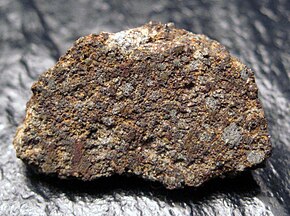| Richardton meteorite | |
|---|---|
 | |
| Type | Chondrite |
| Class | Ordinary chondrite |
| Group | H5 |
| Country | United States |
| Region | Richardton, North Dakota |
| Coordinates | 46°37′30″N 102°16′17″W / 46.62500°N 102.27139°W |
| Observed fall | Yes |
| Fall date | 1918-06-30 |
| TKW | 90 kilograms (200 lb) |
| Strewn field | Yes |
The Richardton meteorite is a 90 kilograms (200 lb) H5 Ordinary chondrite that was seen to fall at 21:48 on 30 June 1918 between Mott, North Dakota and Richardton, North Dakota, United States.[1][2]
Pieces were found in a strewn field of about 9 miles (14 km) by 5 miles (8.0 km) centred on 46°37′30″N 102°16′17″W / 46.62500°N 102.27139°W and oriented north–south.[2] As of December 2012[update] pieces of this meteorite were for sale online at up to US$80/g.[3]
In 1960 John Reynolds discovered that the Richardton meteorite had an excess of 129Xe, a result of the presence of 129I in the solar nebula.[4][5]